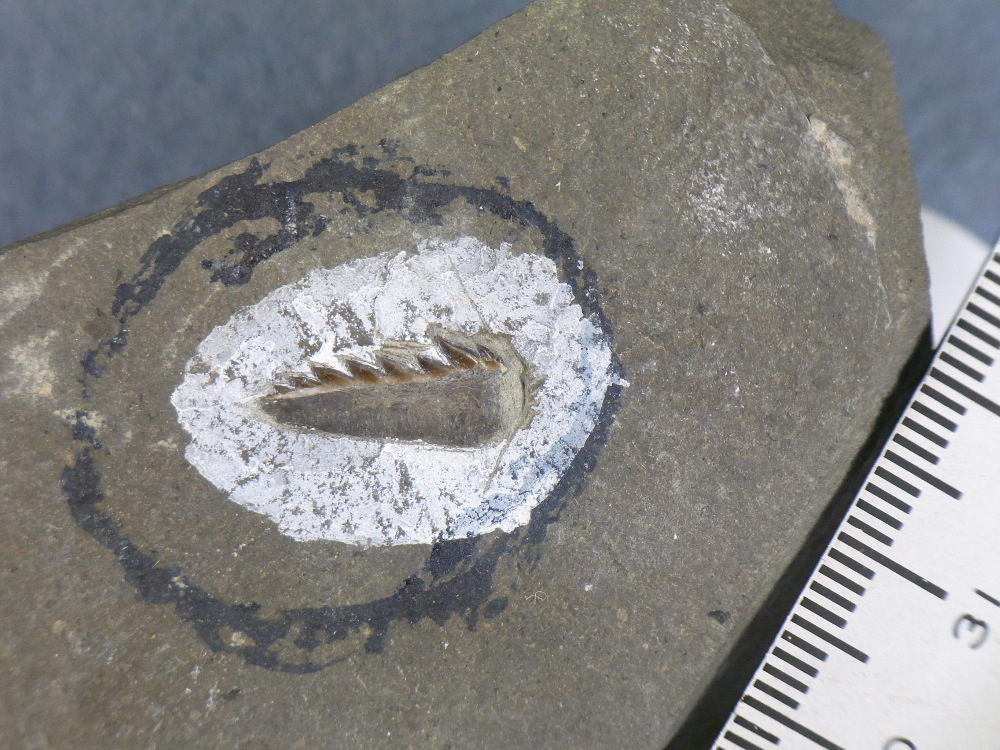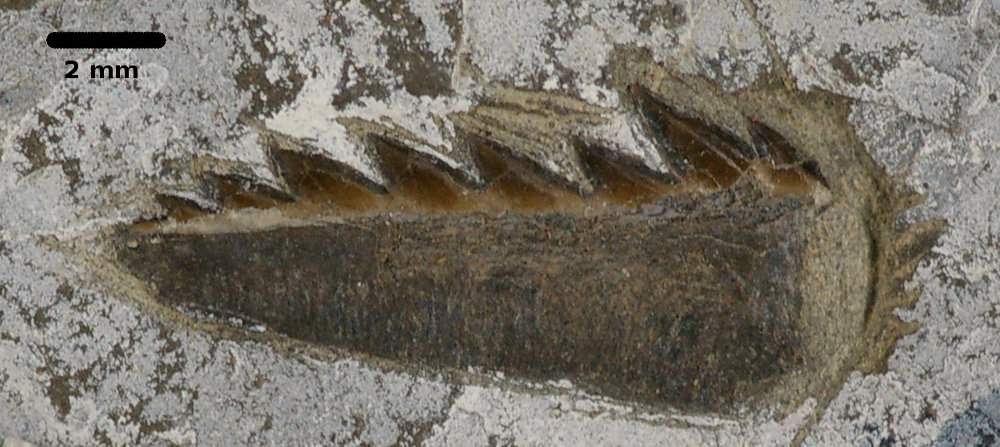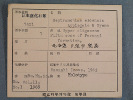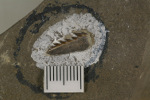Heptranchias ezoensis
Applegate & Uyeno, 1968
Classification: Elasmobranchii Hexanchiformes Hexanchidae
Reference of the original description
The first discovery of a fossil tooth belonging to the shark genus Heptranchias, with a new Pristiophorus spine, both from the Oligocene of Japan. Bulletin of the National Science Museum, Ser. C, 11(2), 195–200
The first discovery of a fossil tooth belonging to the shark genus Heptranchias, with a new Pristiophorus spine, both from the Oligocene of Japan. Bulletin of the National Science Museum, Ser. C, 11(2), 195–200
Image of the original description

Heptranchias ezoensis Applegate & Uyeno, 1968; holotype (NSMT 7421); Kashima, Yubari City, Hokkaido; Upper Oligocene; © Yukimitsu Tomida, National Museum of Nature and Science, Tsukuba City, JAPAN

Heptranchias ezoensis Applegate & Uyeno, 1968; holotype (NSMT 7421); Kashima, Yubari City, Hokkaido; Upper Oligocene; © Yukimitsu Tomida, National Museum of Nature and Science, Tsukuba City, JAPAN
Description:
Citation: Heptranchias ezoensis Applegate & Uyeno, 1968: In: Database of fossil elasmobranch teeth www.shark-references.com, World Wide Web electronic publication, Version 12/2025
Please send your images of "Heptranchias ezoensis" to info@shark-references.com

Heptranchias ezoensis Applegate & Uyeno, 1968; holotype (NSMT 7421); Kashima, Yubari City, Hokkaido; Upper Oligocene; © Yukimitsu Tomida, National Museum of Nature and Science, Tsukuba City, JAPAN

Heptranchias ezoensis Applegate & Uyeno, 1968; holotype (NSMT 7421); Kashima, Yubari City, Hokkaido; Upper Oligocene; © Yukimitsu Tomida, National Museum of Nature and Science, Tsukuba City, JAPAN
Distribution Geographic
type locality: Kashima, Yûbari City, Hokkaido, Japan [85];
other localities:
Distribution of Heptranchidae show google map
type locality: Kashima, Yûbari City, Hokkaido, Japan [85];
other localities:
Distribution of Heptranchidae show google map
Description
Original diagnosis of APPLEGATE & UYENO, 1968 [85]: This tooth possesses eight crownlets and two anterior denticles. The crownlets vary in height, the posterior four becoming progressively longer as one proceeds anteriorly. The fifth almost equals the fourth. The sixth is smaller than the preceding. This is followed by the highest crownlet, which is only slightly larger than the fourth or fifth. Anteriorly there are two denticles, the first being considerably larger than the second or anterior most. The bases of the crownlets arc quite wide, and the blades are like a wide arch in outline. The crownlets and denticles are strongly deflected to the rear. The root is elongate triangular, with the base directed anteriorly; the sides arc quite straight. Measurements of the type are as follows: root width 13.4 mm; greatest root depth 4.0 mm; height of largest crownlet 3.0 mm.
Original diagnosis of APPLEGATE & UYENO, 1968 [85]: This tooth possesses eight crownlets and two anterior denticles. The crownlets vary in height, the posterior four becoming progressively longer as one proceeds anteriorly. The fifth almost equals the fourth. The sixth is smaller than the preceding. This is followed by the highest crownlet, which is only slightly larger than the fourth or fifth. Anteriorly there are two denticles, the first being considerably larger than the second or anterior most. The bases of the crownlets arc quite wide, and the blades are like a wide arch in outline. The crownlets and denticles are strongly deflected to the rear. The root is elongate triangular, with the base directed anteriorly; the sides arc quite straight. Measurements of the type are as follows: root width 13.4 mm; greatest root depth 4.0 mm; height of largest crownlet 3.0 mm.
Remarks
shark-references Species-ID=2729;
Acknowledgment: many thanks to Yukimitsu Tomida, National Museum of Nature and Science, Tsukuba City, JAPAN for the images of the holotype (05/2013);
shark-references Species-ID=2729;
Acknowledgment: many thanks to Yukimitsu Tomida, National Museum of Nature and Science, Tsukuba City, JAPAN for the images of the holotype (05/2013);
References

Late Mesozoic and Cenozoic fish faunas of Japan. Island Arc, 3(4), 255–269
DOI: 10.1111/j.1440-1738.1994.tb00115.x

On Cretaceous and Tertiary Fish Remains from the Hidaka and Yubari Districts in Hokkaido, Japan. [in Japanese] Memoirs of the National Science Museum, 5, 223–225

Fossil Chondrichthyes of Japan. Journal of the Geological Society of Japan, 78(11), 585–600

The first discovery of a fossil tooth belonging to the shark genus Heptranchias, with a new Pristiophorus spine, both from the Oligocene of Japan. Bulletin of the National Science Museum, Ser. C, 11(2), 195–200

Late Mesozoic and Cenozoic fish faunas of Japan. Island Arc, 3(4), 255–269
DOI: 10.1111/j.1440-1738.1994.tb00115.x

On Cretaceous and Tertiary Fish Remains from the Hidaka and Yubari Districts in Hokkaido, Japan. [in Japanese] Memoirs of the National Science Museum, 5, 223–225

Fossil Chondrichthyes of Japan. Journal of the Geological Society of Japan, 78(11), 585–600

The first discovery of a fossil tooth belonging to the shark genus Heptranchias, with a new Pristiophorus spine, both from the Oligocene of Japan. Bulletin of the National Science Museum, Ser. C, 11(2), 195–200


















